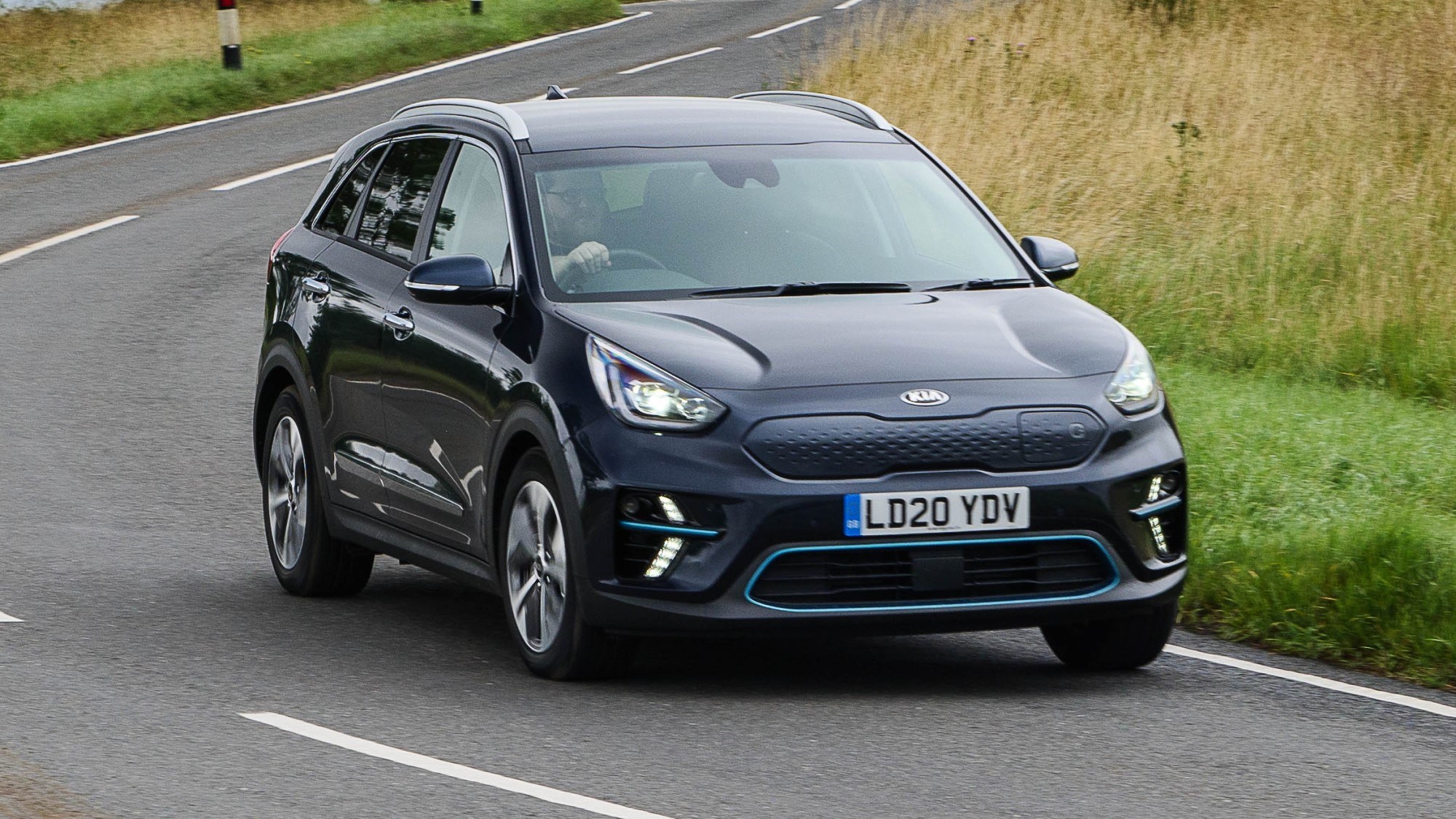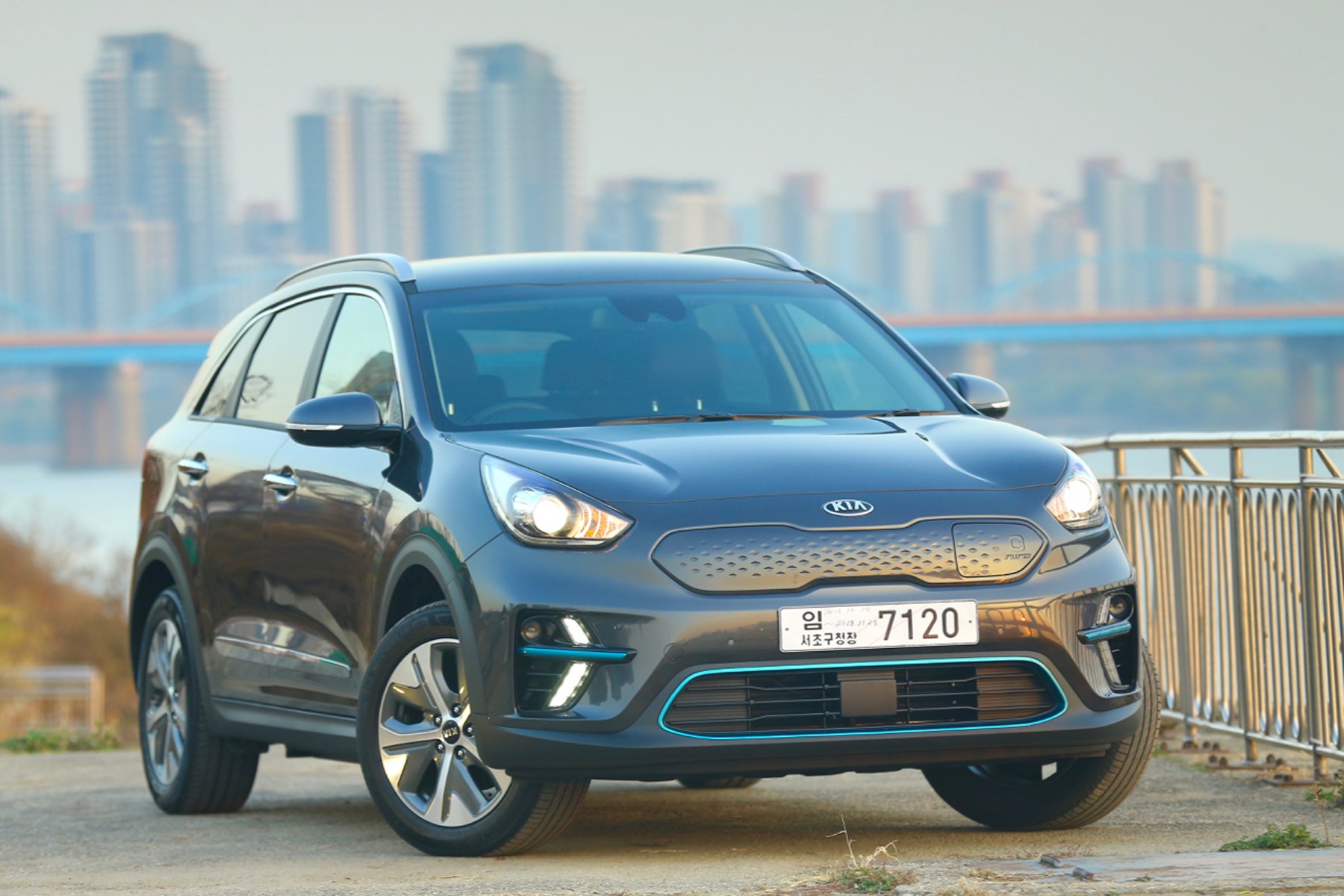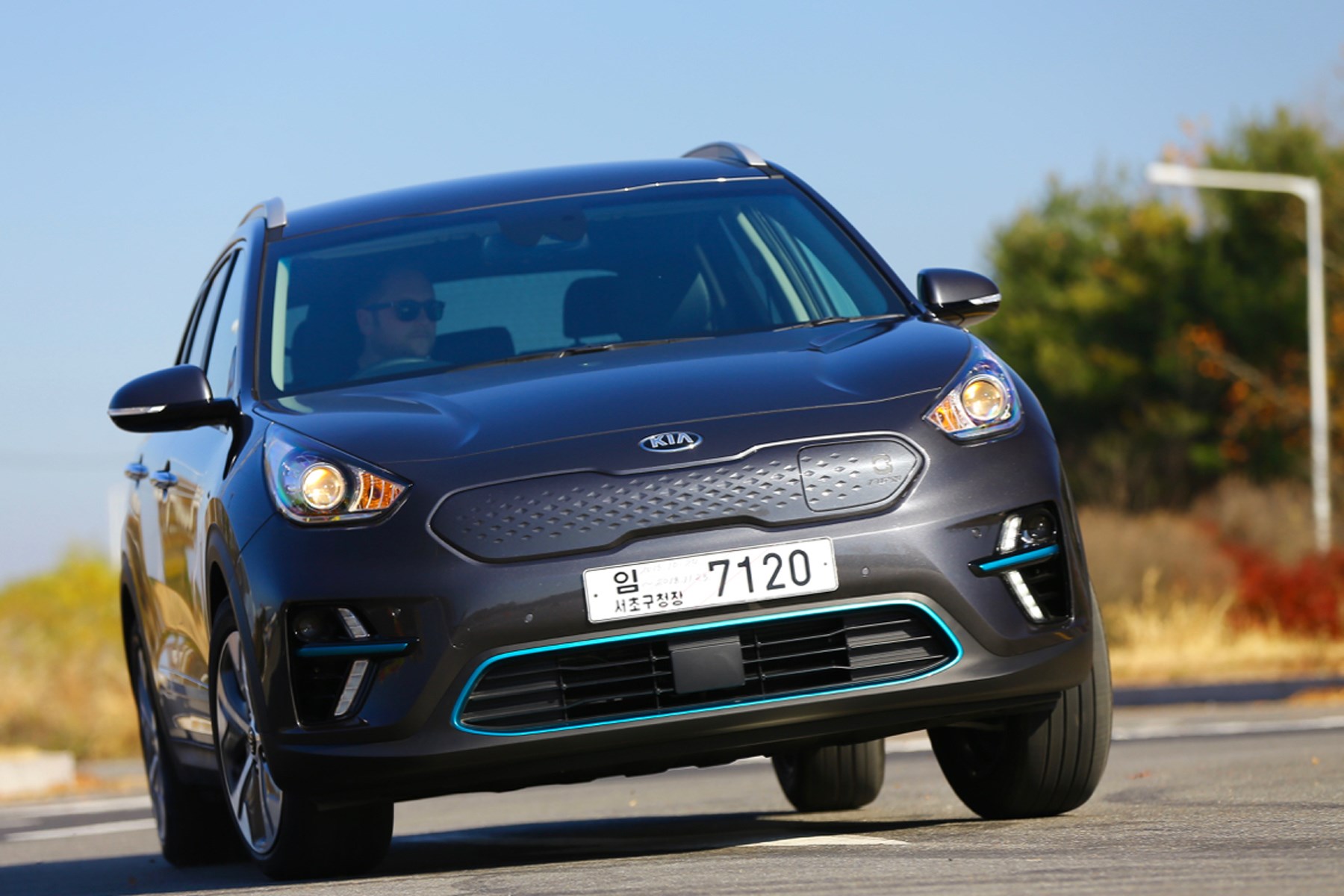► Kia’s most sensible EV tested
► Top-drawer 282-mile range, reasonable price
► E-Niro facelifted for 2020 and better than ever
Demand for the Kia e-Niro was so strong at launch that it sold out. Anybody doubting the UK’s appetite for electric vehicles should be silenced by the sales figures in the years since its launch – global demand for Kia and sister brand Hyundai’s electric cars has been so strong worldwide that they’ve had to ramp up battery production to compensate.
The e-Niro is the most pragmatic choice of all of the group’s EVs, leaving behind the funky styling of the Soul EV or Hyundai Kona Electric for something very under-the-radar. It’s not outwardly desirable – instead, it’s practical, with a big interior and one of the longest all-electric ranges you can get on a car that doesn’t have a Tesla badge.
Best electric SUVs
How do you tell the difference from a regular Niro?
There’s little to tell the e-Niro from its hybrid or plug-in hybrid siblings, or indeed any other compact SUV on the road. That’s the point. This is an electric car for those who don’t want or need to shout about it.

That’s not to say it’s a great looker, but then, what compact SUV is? It’s inoffensive, though items like the chrome door handles and aerodynamic wheels do stand out, and not in a good way. Certainly next to funky, youthful designs like the mechanically similar Soul, the e-Niro isn’t particularly desirable, and it won’t catch the gaze of many Tesla fanboys.
It’s staunchly un-Tesla on the inside too, though that’s actually a good thing. The facelifted e-Niro cabin is a model of common sense, with buttons for all the functions you could want to adjust on the move and a big, clear infotainment screen for all the rest. And that screen’s unusual in that it’s fully integrated, instead of sitting proud on the top like an iPad stapled to the dash.
Best electric cars: our guide
So what’s under the bonnet?
There are two variants of e-Niro available. The former, which we’ve not tested, uses a 39kWh battery pack and 134bhp electric motor, with a maximum range of 180 miles. Decent, but underwhelming figures.
The headline model ups these numbers to a 64kWh battery pack, 201bhp motor and 282-mile maximum range. The latter is one of the best ranges available, and it’s second only to the Volkswagen ID.3 in terms of non-premium electric cars.

Of less importance now, but likely to become more of a factor in the future – the e-Niro is one of the most efficient electric cars you can buy. It uses its battery power very sparingly, which means charging costs you less per mile. In fact, our sister site Parkers found the e-Niro to be the cheapest vehicle to ‘fuel’ out of the entire UK vehicle parc.
As with most electric cars, performance off the line is impressive, but the e-Niro really isn’t suited to putting all its power down at once. All 201bhp goes through the skinny front wheels shod in low rolling resistance tyres, which means they’ll light up at the slightest provocation.
Squeeze the accelerator more gently and you’ll still find there’s tons of low-end grunt – 0-62mph takes just 7.5 seconds, but 0-30mph seems virtually instantaneous. More than accelerative power, what the chunky horsepower and torque figures grant you is enough in reserve that you feel safe travelling at motorway speeds.
Of course, travelling on the motorway will see your range tumble, but the e-Niro’s impressively accurate at forecasting its remaining range. During our time with the car it never ran out of juice prematurely.
Charging takes place via a socket in the car’s nose, hidden behind the blanked-off grille. Max charge rate is 100kW, if you can find a station that provides it – that’ll top it up to 80 per cent in less than an hour. More common 50kW rapid chargers can do the same in 1hr 15 minutes.
If you’re charging at home from a 7.4kW wallbox, as most will, a full charge from empty will take 10 hours. Kia provides a three-pin charger for emergency use, but a full charge from this will take a slug-like 30 hours.
Does it handle?
Not really. There is a Sport mode that weights up the steering, but as mentioned, there’s limited grip and the chassis doesn’t lend itself to enthusiastic driving. It’s rather like the Lexus UX 300e in this regard.

Nor does it really lend itself to pillowy comfort, which is our main gripe with the e-Niro – it just doesn’t ride very well.
Round town that’s not a big problem, though it’s rather firm over pockmarked surfaces or speed bumps. It’s more irritating on a long trip, where the e-Niro never really settles down. That’s an issue shared with its platform buddies, the Hyundai Kona Electric and the Kia Soul, but not one you’ll find in a Tesla Model 3 or VW ID.3 – both of which are quite supple and settled over bumps.
What’s it like inside?
It’s roomy enough for a family but five adults will struggle. It’s a size class below a true family SUV like a Skoda Karoq, though, so particularly demanding users would be better served by a bigger electric car – like an Audi e-Tron, or perhaps a large plug-in hybrid such as a Ford Kuga PHEV.
It’s sensible, however, with a nice square roofline and big, wide-opening doors. The boot, too, is a useful 451 litres in capacity.

The front of the car is very pleasing indeed, though. Before the 2020 facelift, it was rather plasticky and anonymous – now, it’s sleek and actually quite attractive, particularly the way the 10.25-inch infotainment display is fully integrated into the dashboard.
Equipment’s generous – all cars get Apple CarPlay and Android Auto, adaptive cruise control, keyless entry and a reversing camera, but it might be worth heading to the top-spec trim for an upgraded sound system and LED headlamps.
Verdict
The new VW ID.3 gives strong competition, but the Kia e-Niro’s still one of the better electric cars you can buy at the affordable end of the spectrum. Decent to drive, well-equipped, well-built and with more than enough range to satisfy most people’s needs, there’s a lot to like about this car.
Kia e-Niro: driven in Korea
We’re told Kia’s trying to forge its own path in Europe, and that it’s doing so by launching a swathe of vehicles that differ from parent company Hyundai’s offerings. But what we have here on the face of it might seem to contradict that fact, since the E-Niro is very similar in concept to the Kona Electric. After all, they’re both small SUVs with nearly 300 miles of range, priced just above £30k with the reduced UK plug-in grant and loaded with standard kit.
In fact, the car you can see here is the only version we’re getting in the UK. Kia offers a lower-range version elsewhere, but is unable to price that effectively enough to compete with the slightly smaller and cheaper Kona Electric. So instead the E-Niro is here in bells-and-whistles 3 specification, and your only factory options choices are a spread of six colours.
It’s a very simple car to spec and choose, then. But is it as good as the hype suggests? Read on for our full Kia E-Niro review.
Hang on – they don’t look like UK numberplates!
Good spot. They’re not. They’re Korean, because we’ve been driving these cars in Seoul shortly before they embark on a 4300-mile boat ride to our shores to serve as a training and demo fleet for British Kia dealers as they begin the push for electrification.
There’s a new Kia EV coming every year for the next three years, you see, and salespeople are going to need their ducks in a row if the Koreans are going to succeed in the zero-emissions marketplace.
So in fact while we’re driving on the right, the nicely trimmed, white-stitched leather steering wheel’s on that side too. Not an issue, except the sat-nav system only has European mapping. Apple CarPlay to the rescue…
Our journey begins at the Korean automotive powerhouse that is the twin towers of Hyundai and Kia’s global headquarters, which is in a busy industrial area of Seoul. That means one thing: traffic. There are thousands of motorists constantly jostling for position on the multi-lane expressways that course through the city. It’s a frenetic place to get to grips with a new car, but thankfully at least we’re dealing with a smaller SUV here. The E-Niro’s dimensions place it a sector above its Kona cousin, but it’s still not a large car and feels neatly nimble at low speeds.

Electric propulsion helps here too, of course. Prod the right pedal and this Kia leaps forward with entertaining urgency. We’re wide-eyed on our first attempt, and chuckling to ourselves regularly thereafter with the immediacy of thrust available here as we nip between lanes to make progress.
Kia E-Niro: addictive acceleration as standard
It’s nothing new for EVs to have 100% of torque available from 0rpm, but our preconceived notion having read the spec sheet of 0-62mph in only 7.5 seconds had set us up for disappointment in the face of Teslas with Ludicrous Mode and the like. Although the thrust on offer might not throw this Kia through the sound barrier, it’s still instantly gratifying and genuinely feels quick.
The steering helps here too, because its light weighting (in normal mode at least) coupled with the batteries’ location low in the platform for a favourable centre of gravity gives this 1.8-tonne SUV an agility that belies its mass. Dynamically it’s accomplished in a way that a Nissan Leaf simply is not.
Don’t get us wrong here though – this isn’t meant to be a cooking crossover. The real story here is the fact that the new Kia E-Niro is a useable family hatchback with a practical range and a low purchase price. But it shows you don’t necessarily have to sacrifice fun to achieve that.
Our plan, once out of Seoul, was to drive towards the town of Imjingak at the southern edge of the demilitarised zone (colloquially dubbed DMZ – the dee-em-zee) between North and South Koreas. Built in 1972 in hope of reunification following the Korean war – which officially never ended – this is where both sides signed a treaty in April 2018 to officially end hostilities before the year is out.
However, it’s also located a few hours’ drive from Kia HQ, meaning a good round trip to test whether that claimed combined range of 282 miles is anything resembling realistic.
Time to leave: our Kia E-Niro road trip
Once comfortable, adjusting the electric front seats and steering wheel (which oddly for a car at this price isn’t on a telescopic column, so only moves vertically), it was time for the off. Turn the drive-by-wire transmission selector to D, and our tyres squealed over the painted surface towards the car park exit.
We started with 345km (214 miles) of range showing on the digital instrument cluster, and we’d decided this has to be a real-world test: no hypermiling, full air-con or heating as required, and full use of the additional creature comforts on the spec list. A chilly wind cutting through the car park meant heating for front seats and steering wheel was welcome, while my mobile was plonked onto the ridged inductive chargepad located under the screen.
This last impressed, because within 25km (16 miles) of range used on the car’s batteries, my mobile phone had charged from 86% to full, with a beep and a green light to let me know I could remove it from the pad to avoid unnecessary energy wastage. Not new, granted, but neatly integrated. Things were off to a good start.
Once that traffic began to thin it gave us the ideal chance to sample Kia’s latest driver-assistance tech. Again, there’s nothing groundbreaking here, but what stood out was the non-intrusive nature of its operation. The active lane-keeping was subtle enough that we really had to concentrate to feel it nibbling at our trajectory, and the adaptive cruise control metered performance and braking smoothly but with enough urgency that fellow motorists didn’t lose patience.
Humans still do it better
Only once did it fail to spot a van in front had left my carriageway and joined a sliproad, slowing unnecessarily. But that isn’t unusual with contemporary systems. It’s just a reminder that in reality the organic squashy part behind the wheel isn’t anywhere near redundant just yet.
Still, the 90kph (56mph) maximum speed limit hadn’t exactly given us the opportunity to wring the neck of the E-Niro just yet, so getting to know its low-speed manners was the aim of the game. The noise struck us – this driveline is highly audible, both inside and outside the car, whining and thrumming as speeds change. Of course, the lack of an internal combustion motor plays a big part here, because the baseline noise level is much lower, but we noticed quite a bit of road noise telegraphed through the 17-inch wheels. The ride felt a little harsh too – the car’s kerbweight doesn’t help here either.

But with that said, the seats are great and you’ll presumably have the stereo on for the most part, so neither is a true dealbreaker.
We couldn’t test much of the multimedia given we were completely reliant on CarPlay to guide us around Korea, but it’s fair to say the cabin design of the E-Niro is premium enough to command £33k on a Kia forecourt.
Once we’d pulled into the vast car park next to the fairground and restaurants at Imjingak Resort – you’d be forgiven for thinking this area feels in any way tense given recent global events, but it doesn’t – we parked up for some lunch.
The nearly flat boot floor in the E-Niro made for a nearly comfortable perch to sit on while we consumed our individually wrapped sandwiches (single-use plastic is ubiquitous in Korea, but then so is effective and rigorously enforced recycling legislation…). This gave us a chance to consider the styling of this car against the other Niros – there’s a mild-hybrid model and a PHEV on sale too. You’ll spot the EV by its bespoke front and rear bumper designs, and an aerodynamically friendly closed version of Kia’s family Tiger Nose grille design.
Why is the Kia E-Niro an SUV?
It also gave us pause to consider why Kia’s building an electric SUV, rather than a bodystyle better suited to eco-friendly motoring. A tall stance and chunky proportions don’t immediately lend themselves to the best-possible aero performance, but then again a sensible car company will need to build cars people actually want to buy, too.
Group design boss Peter Schreyer was unequivocal when CAR asked why an SUV: ‘I think the SUV is the normal car now. They have been developed out of being an off-roader. It comes from the Land Rover or the Jeep or whatever, but I think what the benefit of an SUV is they’re very practical. You have a high seating position, you have an overview and you feel safe, and this is what makes an SUV and why they are so successful. It’s not because they are capable of going over terrain.’
So there we have it. No off-roading for us on this trip, and while it might have a slightly rugged look, the E-Niro is unlikely to be tackling anything tougher than a kerb or two.
Heading back south away from the border and towards Seoul on some of the twistier roads in the region, it was time to engage Sport mode and give this crossover some stick.
It was largely as we’d expected, frankly, with numb steering and a touch more bodyroll than we’d prefer to stitch a set of switchbacks together. But once you’ve got your head around the extra movement, we found the chassis predictable and nimble when applying steering inputs. It’s no Hyundai i30 N hot hatch on the twisties, but again the E-Niro doesn’t fall apart when keen driving is demanded of it.
Parking up at the end of our long day’s driving, the range read-out on the instrument panel said we’d still got over 100km (62 miles) left in the batteries. Considering this test was meant to challenge E-Niro in conditions as close to real life as possible, we came away very impressed.
Verdict
The E-Niro looks very similar on paper to the Kona Electric, but don’t let that fool you. We think there’s enough vim and vigour here to make waves in its own right, and can see the appeal of E-Niro over parent firm Hyundai’s attempt.
With its genuine 300-mile capability and useful, modern technology, the E-Niro feels like the new normal.
View Kia E-Niro lease deals
More Kia reviews by CAR magazine